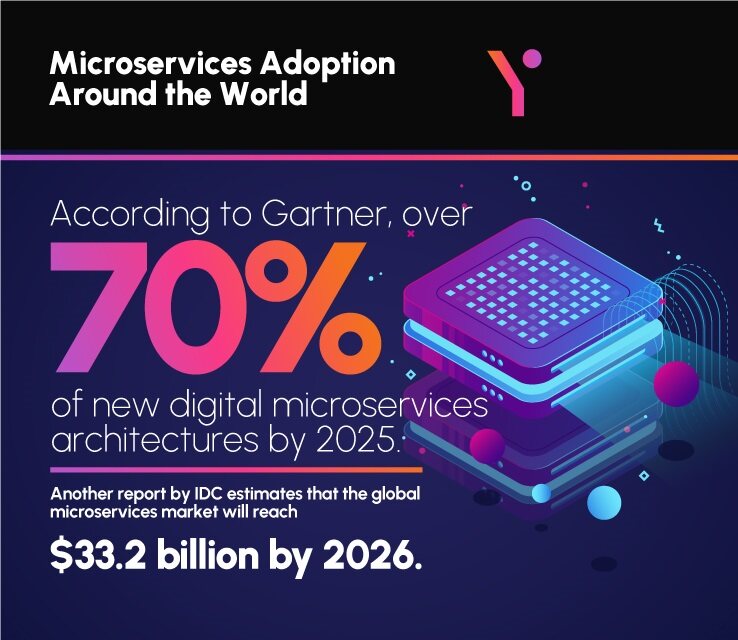Introduction
Wondering if microservices are suitable for your business? This blog has everything you need to know about pros cons microservices. Weigh the benefits and drawbacks and gain insights from real-world examples – Microservices might be your game-changer or a path towards ultimate success!
Microservices have taken the tech world by storm, lauded for their agility, scalability, and freedom. But are they truly the silver bullet for every application, or just trending for no valid reasons? Join us as we will shed light on the hidden truths behind microservices.
We’ll delve into the potential that promises agility and innovation, but also unmask the complexities like the development overhead and operational challenges.
So, is a microservices architecture the right fit for your business? Let’s ‘weigh the pros cons microservices, together.
What Does It Mean by Microservices?
In simple words, Microservices are basically a way of building software where you break down your application into smaller, independent pieces. Each piece or service focuses on doing one specific job.
Microservices are like a team of specialised experts working together, each of them handling a specific task, like payments or user accounts. Similarly, microservices divide a software application into separate services, each handling a specific function.
Those independent pieces or blocks communicate with each other through APIs to fit together to build fully functional applications.
The purpose of this modular approach is to enable more efficient development, flexibility, and scalability. In most cases, a company offering custom website development services often leverages microservices architecture to customize solutions that precisely meet your needs.
What’s the Hype Behind Microservices?
So, why are people so excited about microservices? Well, first off, they make custom app development much easier and save you time.
With traditional software, if one component gets overloaded, the whole application can slow down. But with microservices, you can scale up just the components that need it without affecting the rest.
Microservices also give developers more freedom. Since each service is independent and easy to manage, teams can choose the best tools and technologies for each one.
The key point of attraction is, with microservices, if one service goes down, it doesn’t bring the whole system crashing down with it. It’s like having a backup plan for your application – if something goes wrong, the rest can keep chugging along.
So yeah, the hype around microservices is real!

Pros of Microservices
Microservices have garnered a lot of hype in recent years due to several perceived advantages over traditional monolithic architectures. Here are some key reasons why they’ve generated so much buzz, and providers of web development services often utilise it.
Agility and Development Speed
Microservices can be developed and deployed independently. Each team owns and manages its own service, leading to smaller and simpler codebases. This can be extremely beneficial for large organisations with multiple development teams.
Scalability and Fault Tolerance
Microservices architectures are designed to handle failures gracefully. Additionally, the service ensures that an issue in one service won’t necessarily bring down the entire system, increasing overall resilience.
Technology Freedom
Different microservices can be built with different technologies, allowing developers to use the best tool for the job. This freedom brings innovation and avoids being locked into specific technologies.
Organisational Alignment
Microservices can be aligned with specific business domains, enabling teams with ownership and expertise in those areas to manage their service. Due to this, cross-functional collaboration and understanding become easy.
However, it’s important to remember that microservices aren’t a silver bullet, and there are certain cons of Microservices:
Complexity
Distributed systems can be complex in terms of development, deployment, monitoring, and debugging. Organisations without the necessary expertise or tooling will find microservices hard.
Development Overhead
Building and maintaining multiple smaller services can require more development effort compared to a single monolithic application. Additionally, ensuring communication and coordination between services can add complexity.
Operational Challenges
Monitoring, logging, and security become more complex in a microservices environment, requiring robust infrastructure and tools. Data management and consistency across services also need careful consideration.
Cost
While microservices offer potential cost savings through better resource utilisation, the increased complexity can lead to higher upfront costs for infrastructure and expertise.
Ultimately, the hype surrounding microservices stems from their potential to provide agility, scalability, and tech freedom for large organisations. However, it’s crucial to understand the trade-offs and challenges involved before making a decision. Carefully consider your specific needs and technical capabilities before diving into the world of microservices. For instance, you might not require microservices for WordPress website development, but you will need them for custom web development. So, have a clear understanding before making any decision.
Why Companies are Adopting Microservices
Companies are adopting microservices to accommodate rapid growth and scalability demands. It enables them to manage increasing workloads without over-provisioning resources.
Microservices can empower development teams to work autonomously on smaller, more manageable components. This autonomy fosters innovation, collaboration, and ownership, leading to increased developer productivity and job satisfaction.
The freedom of managing and streamlining tasks enables the app development company to focus more on innovation and creativity. Moreover, we have seen in recent times that all the big companies are embracing microservices to increase quality and decrease manual task management.
Monolith vs. Microservices
A monolithic architecture is characterised by a single, cohesive codebase that contains all the components of an application. While monolithic architectures are simpler and easier to develop and deploy initially, they can become cumbersome and challenging to scale as the software grows.
Microservices breaks down an application into smaller, independent services, each focused on a specific function. While microservices offer scalability, agility, and fault tolerance, they also introduce complexity and forward-thinking to stay ahead.
Is Microservices Right for You? Assessing Your Needs
Before jumping into microservices, assess your organisational needs and requirements. Here are some essential factors to consider:
If you require custom android app development that anticipates rapid growth in user base or workload, microservices could be a suitable solution.
For example, Netflix adopted microservices to handle millions of concurrent users by breaking down its monolithic architecture into smaller, independently scalable services.
Microservices are ideal if you want to deliver new features and updates quickly.
For instance, Amazon’s retail platform utilises microservices to iterate rapidly and respond swiftly to changing customer demands, facilitating continuous innovation.
Microservices offers a diverse set of technologies and tools for different components of your application. It can be useful if you require specific technologies and tools on different levels.
For example, Spotify’s microservices architecture allows it to integrate various technologies, such as Java, Python, and Go, to deliver personalised music recommendations and streaming services.
If your concern is operational complexity tolerance, microservices are for you. It handles the operational overhead associated with managing a distributed system of microservices.
For example, Google’s Kubernetes platform provides tools for automating the deployment and management of microservices, reducing operational complexity and overhead.
Thoroughly identify your requirements to determine whether microservices are the right architectural approach for you. Remember to weigh the pros cons microservices to make an informed decision that aligns with your business objectives.
Alternatives to Microservice that You May Consider
Microservices with a hybrid approach
You can start with a microservices architecture for specific functionalities and keep parts of your system monolithic for simplicity.
Event-driven architecture
Consider this if decoupling components and asynchronous communication are key requirements.
Serverless functions
You may also utilise cloud-based solutions for short-lived tasks without managing infrastructure.
Future Trends and Developments in Microservice
The buzz around microservices is justified, and the road ahead promises exciting advancements that will push this architecture even further.
Here’s a look at some key trends to keep an eye on
Increased Adoption of Service Meshes
Service meshes are simplifying the management of complex microservice-based applications by offering features like load balancing, security, and observability. They’re expected to gain more traction, so you may focus on core business logic.
Serverless Computing Gains Traction
Serverless architectures are the talk of the town for their ability to automatically scale up and down based on real-time usage without the hassle of managing servers.
Focus on Observability and AI-powered Operations
We’ll see advancements in observability tools leveraging AI and machine learning for automated anomaly detection, root-cause analysis, and self-healing for operational efficiency and uptime.
Edge Computing and Microservices Integration
As edge computing gains momentum, integrating it with microservices will be of high value. Services deployed closer to data sources will enable real-time processing and low latency for IoT applications and geographically distributed systems.
Security Takes Center Stage
Security can make or break any architecture, and microservices introduce new attack surfaces. We expect to see microservice-specific security best practices to secure communication protocols entirely.
Hybrid Approaches Become the Norm
Not every application requires a full-fledged microservices architecture. Therefore, Hybrid approaches, where monolithic and microservices coexist, will be common.
Wrap Up
Quick summary: microservices offer significant benefits like scalability and agility, but they also come with challenges such as increased complexity. As we have weighed the pros cons Microservices, it will now be easier for you to identify the needs of microservices.
Looking ahead, trends like service meshes and serverless computing promise to enhance microservices further. Ultimately, deciding whether microservices are right for your organisation requires a careful assessment of needs and capabilities. By staying informed and considering these factors, organisations can make informed decisions about adopting microservices to drive their software development efforts forward.
Frequently Asked Questions
Microservices are the small building blocks of software. Instead of one gigantic software that does everything, you have lots of smaller components, each doing a specific job. These blocks merge to make the whole thing work.Some examples include scalability on demand, agile development, tech stack freedom, fault tolerance, and independent ownership.
Microservices have benefits like scalability, agility, and fault tolerance. However, they also bring challenges like complexity, development overhead, and operational hurdles. Therefore, It’s important to weigh these pros cons microservices to decide what’s best for your organisation.
To decide if microservices are right for you, consider factors like your development speed, scalability needs, and operational complexity tolerance. You’ll also want to evaluate your team’s capabilities and resources. By weighing these factors against the pros cons microservices, you can make an informed decision.
Yes, there are alternatives to microservices, like monolithic architectures or hybrid approaches. Monolithic architectures have all the code in one big piece, while hybrid approaches mix microservices with other architectures. It depends on your organisation’s needs and preferences.
Companies like Amazon, Netflix, Airbnb, and Spotify have successfully implemented microservices. For example, Netflix uses microservices to handle millions of users and deliver personalised content, while Amazon uses them to scale their e-commerce platform. These companies show how microservices can be powerful in real-world applications.
Have questions or feedback?
Get in touch with us and we‘l get back to you and help as soon as we can!





